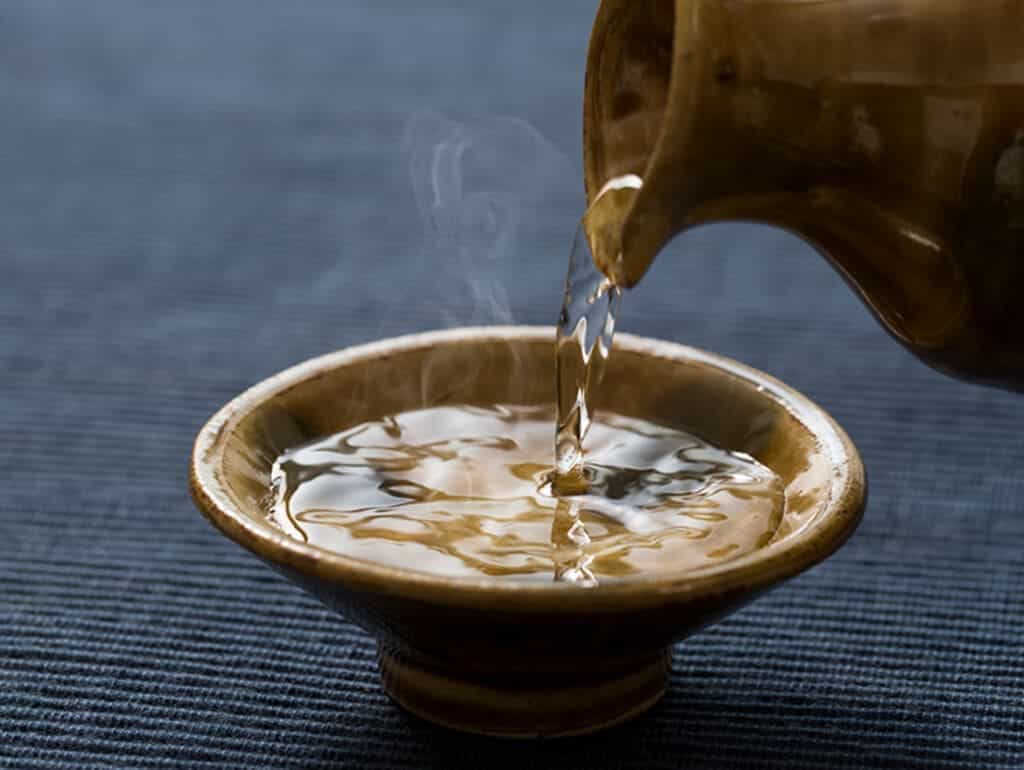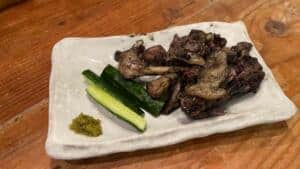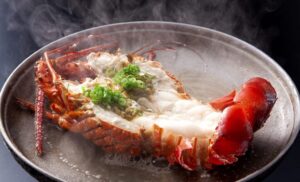Warmed sake, or kanzake (燗酒), is a cherished tradition in Japan, particularly enjoyed during the colder months. This method of heating sake brings out different flavors and aromas that can transform the drinking experience. In this article, we will explore the cultural significance of kanzake, how it’s prepared, the different temperatures and their effects on the taste, and the types of sake best suited for warming. Keep reading to learn more about this time-honored practice and how you can enjoy warmed sake like a true connoisseur.
What is Warmed Sake?

People who have just started enjoying sake may want to drink it warm. Warmed sake is called kanzake. Also, okan refers to the act of heating sake. One of the joys of sake in particular is tasting it warm and drinking it warm. Warm sake or kanzake is sake heated to make it more delicious and generally refers to sake boiled in hot water. Warming sake brings out delicate flavors and aromas that are hard to detect at room temperature or when chilled, so the appeal of warm sake is that you can enjoy the unique characteristics of the sake, such as its umami and richness.
Temperature range and name of warmed sake

| Types of Warmed Sake | Temperature | Taste |
|---|---|---|
| Hyugakan | 30℃ | The sour and umami flavors begin to emerge clearly. It has a smooth taste that is neither warm nor cold. |
| Warm to body temperature | 35℃ | The aroma of rice and rice malt stands out, and you can enjoy a soft flavor. This is the gentlest temperature range for warm sake. |
| Warm sake | 40℃ | The sake’s flavor is fuller and has a rich aroma. Recommended for pure rice sake. |
| Jokan (warm sake) | 45℃ | You can enjoy the aroma that rises with the steam and the crisp aftertaste. Recommended for honjozo sake. |
| Hot sake | 50℃ | The aroma and flavor are sharper, resulting in a crisp taste. Perfect for cold days. |
| Tobikirikan (exceptionally warm sake) | 55℃ | The sourness and spiciness are more pronounced. Recommended for dry, elegant sakes and kimoto sakes. |
| Shinshu-ji Warm Sake | 55℃-65℃ | The taste changes dramatically to a drier flavor, making it a little different from regular warm sake. Recommended for regular sake. |
Warmed Sake History

In Hida, due to the cold climate, there’s a strong tradition of drinking hot sake, even in the summer. If you order sake at an izakaya, it’s common for hot sake to be served automatically. Locals especially enjoy extremely hot sake, heated to around 55°C to 65°C, and in Hida Furukawa, this type of piping hot sake is known as “Shinshu-ji, Shinshu-jikan.” The name comes from a local temple called Shinshu-ji, where a past head priest loved his sake so hot that he couldn’t hold it with his bare hands.
The Health and Beauty Benefits of Warmed Sake
Beauty Benefits
Whitening and Blemish Prevention
Sake contains kojic acid and ferulic acid, both of which suppress melanin production. Kojic acid reduces the melanin that causes spots by suppressing the action of tyrosinase. Ferulic acid also suppresses melanin production in the same way.
Hydration and skin texture
Sake is rich in amino acids (glycine, serine, aspartic acid, etc.) that act as natural moisturizing factors (NMF) to improve skin hydration and texture. Serine, in particular, is a moisturizing ingredient that is the source of the skin’s natural moisture.
Skin elasticity and radiance
Alpha-EG (alpha-ethyl glucoside) in sake increases the amount of collagen in the dermal layer of the skin, which helps to improve skin elasticity.
Health effects
Promotes blood circulation and regulates body temperature
Sake contains adenosine, which promotes blood circulation. By raising body temperature, it improves blood flow throughout the body, reduces muscle stiffness, and speeds recovery from fatigue.
Anti-aging and antioxidant effects
Sake contains ferulic acid, a type of polyphenol that inhibits reactive oxygen species and has effects related to skin aging, such as wrinkles. It also promotes cell activation and may be effective in promoting hair growth and preventing aging.
Disease prevention
Sake contains anti-cancer substances, insulin-like substances, and peptides, and is expected to prevent and inhibit diabetes, heart disease, high blood pressure, and amnesia.
Drinking Precautions
When enjoying heated sake, it is important to observe the proper amount. Excessive drinking is harmful to health, and drinking under the age of 20 and driving under the influence of alcohol should be avoided at all costs. Warming is a good way to get it into the body.
3 recommended brands to enjoy Warmed Sake
Dewazakura Karesansui
Manufactured by: Dewazakura Sake Brewery Co., Ltd.
Founded in 1893 (Meiji 26).
This is a matured sake that has been stored at a low temperature (5℃) for three years. Warming adds a sweet, plump, soft flavor to the original light and smooth taste. It also brings out the unique aroma of the matured sake. It truly has an elegant, mellow flavor. We recommend drinking it warm.
Black pine sword diamond
Manufactured by: Kenbishi Sake Brewery Co., Ltd.
Founded in 1505
This brewery has a tradition of about 500 years. This dry Junmai sake has a strong rice aroma and a sharp yet mellow taste. The rice polishing ratio is changed every year to adjust the taste. We recommend drinking it warm to hot. Warming it up brings out the rice aroma, and it seems to add richness in addition to the sourness and spiciness.
Black Dragon Kuzuryu Daiginjo Warm Sake
Manufactured by: Kokuryu Sake Brewery Co., Ltd.
Founded in 1804.
This is a Daiginjo sake for warming that has been researched and aged to improve the taste of the sake. While maintaining the delicate and elegant quality of Daiginjo sake, you can feel the sweetness and mellowness of the rice, and enjoy the exquisite warming. We recommend drinking it at “human body temperature”.
FAQ
- What is the season for heated sake?
The season for heating sake is from Chou-you-no-Sekku on September 9 to Momo-no-Sekku on March 3 of the following year.
- How to warm up heated sake?
Put the sakkuri in a pot of boiling water to warm it up or
Use a microwave with a sake mode or warm slowly at a low wattage.
Recommended Restaurants for Warmed Sake
GEM by moto

This store offers a flexible selection of sake, from modern brands such as “Aramasa” and “Senkin” to doburoku and full-bodied sake. When they warmed the sake, its richness, flavor, and aroma open up, and it often pairs better with food. And when it comes to warm sake, the store delicately adjusted the aroma not only by temperature but also by adding a small amount of water and by pouring from a chirori into a tokkuri.
Final Thoughts

We hope this article has given you a clear understanding of kanzake and its unique place in Japanese culture. From its rich flavors to its warming qualities, kanzake offers a special experience that is truly worth trying. We, the writers, hope that you feel inspired to enjoy a cup of warmed sake during your visit to Japan and experience this delightful tradition firsthand.
There are other sakes and Japanese drinks you can try.
FAQ
What is kan-zake (warmed sake)?
Kan-zake means sake warmed to enhance aroma and flavor, often enjoyed in colder months.
Which sake types suit warming?
Junmai and honjozo styles suit warming well because their umami and body improve with heat.
What temperature ranges do people use?
Common ranges: nurukan about 40°C, jōkan about 45°C, and atsukan about 50°C. Choose by taste.
How do I warm sake properly at home?
Place the sake bottle or tokkuri in a hot-water bath and heat slowly to the desired temperature—avoid boiling.
Does warming change alcohol content?
Warming does not change alcohol percentage, but warmer sake can make alcohol feel more noticeable on the palate.
Which foods pair best with kan-zake?
Pair with warm, umami-rich dishes like oden, grilled fish, stewed dishes, and yakitori for harmony.
Can every sake work warm?
Some delicate ginjo sake lose subtle aromas when hot; test a small amount first to see if you like it warmed.
How should I serve kan-zake?
Use a warmed tokkuri (ceramic flask) and small ochoko cups to keep temperature and aroma steady while sipping.
Does kan-zake suit beginners?
Yes. Warming can soften strong flavors and make sake more approachable for new drinkers.
Can I reheat kan-zake multiple times?
Avoid repeated reheating; heat once to the preferred temperature and drink it while warm.
Is kan-zake popular in bars and izakaya?
Yes. Many izakaya offer warmed sake options, especially in winter, and list recommended temperatures.
Any tips for tasting warmed sake?
Sip small amounts, note aroma changes as it cools, and compare temperatures to find your favorite style.
















Comments